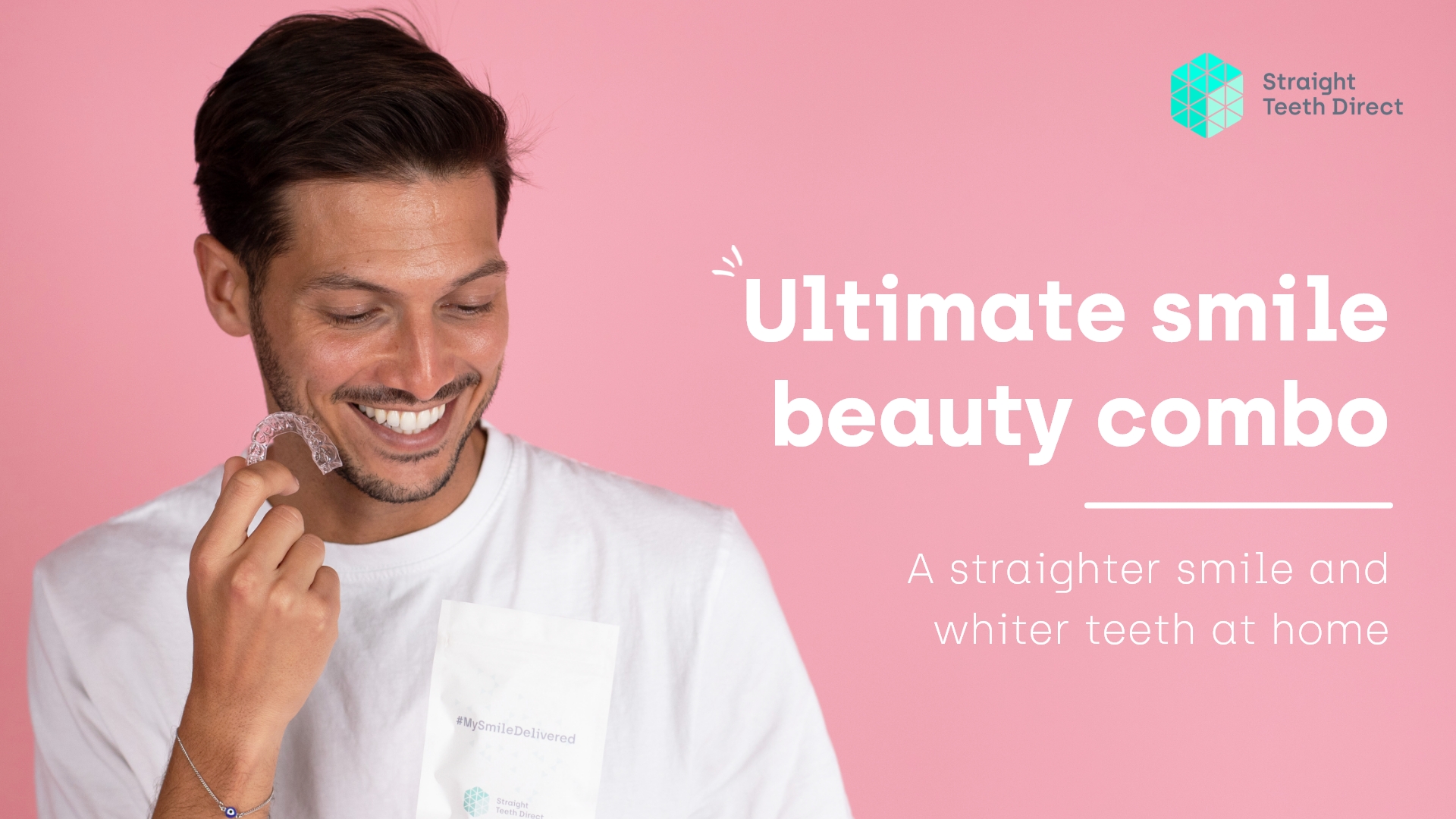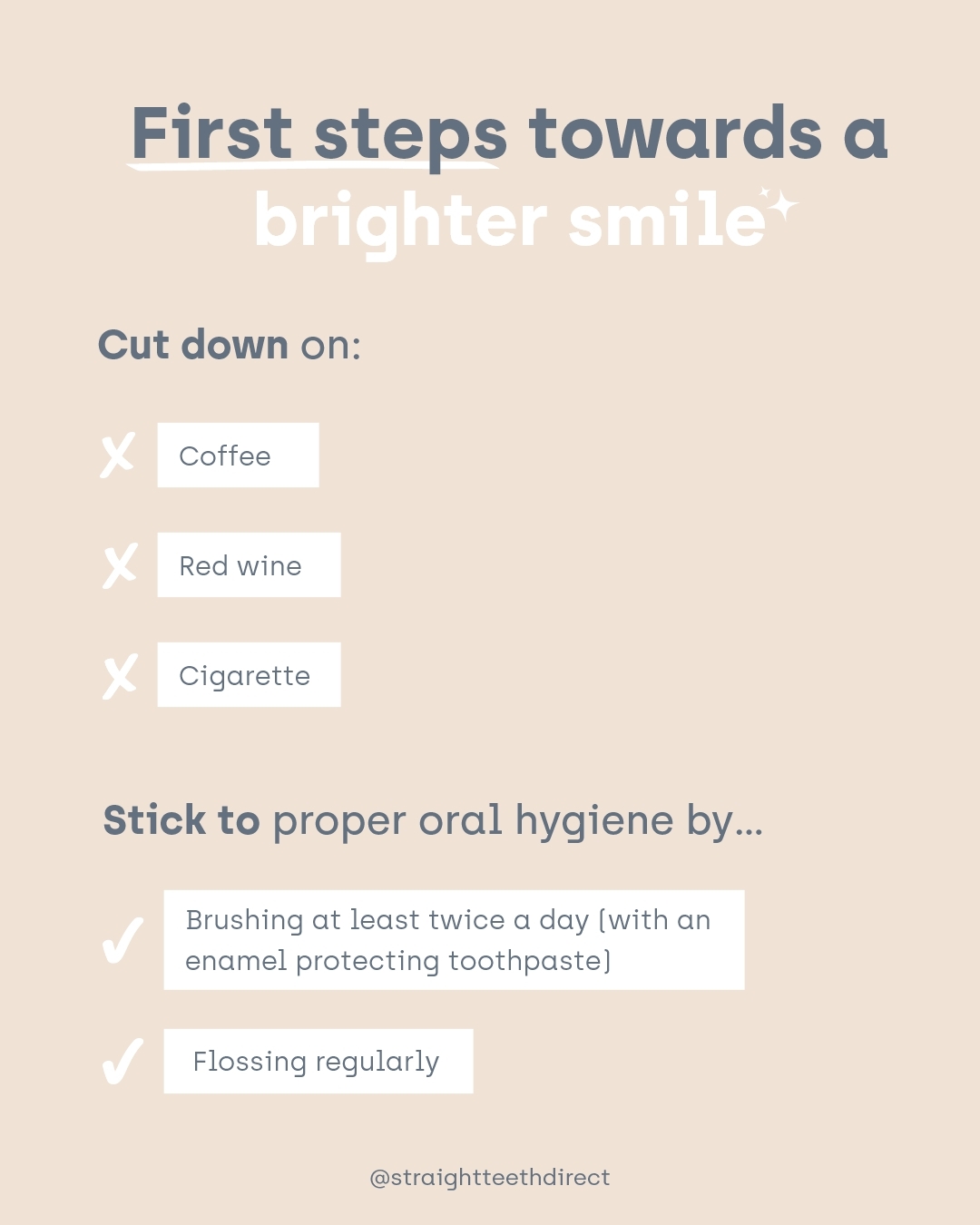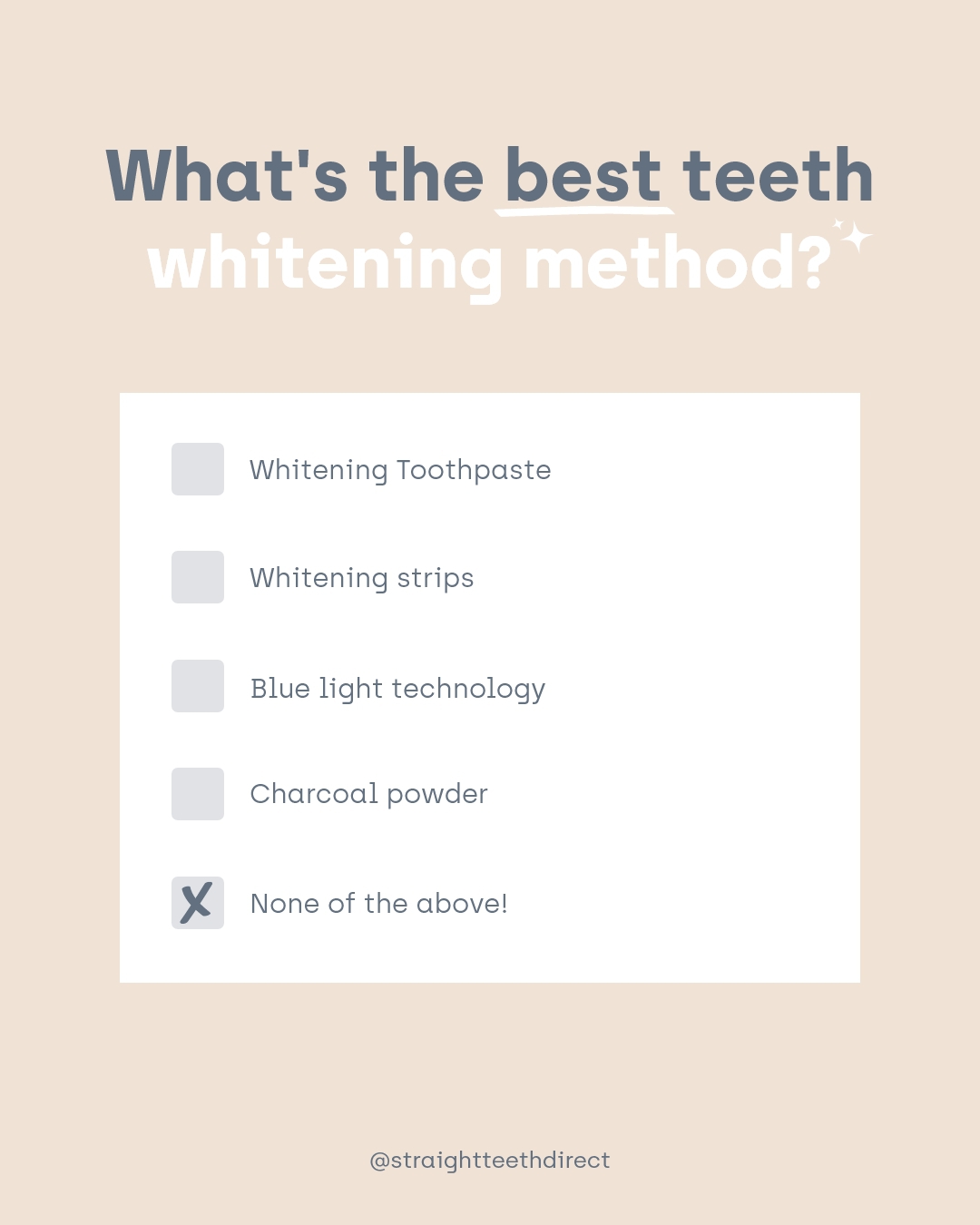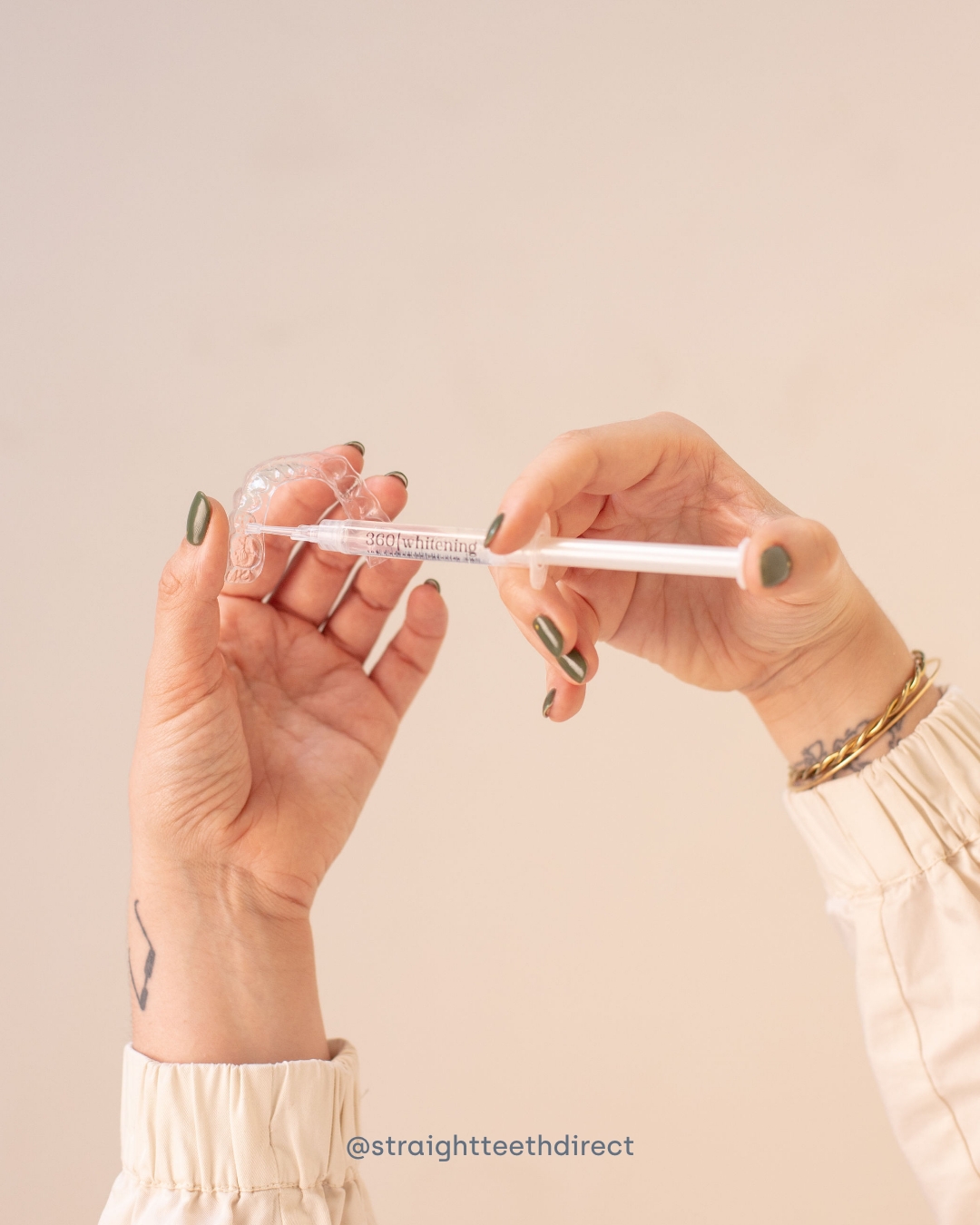
Ultimate smile beauty combo: A straighter smile and whiter teeth at home

Table of contents
#1 Your options for whiter teeth
#2 So…which teeth whitening kit is the best?
#3 Got any teeth whitening questions? We’re here to answer them!
One thing that sits right alongside straighter teeth on many people’s “Perfect Smile Checklist” is to get whiter teeth at home. A staple of the rich and famous, achieving a brighter smile has never been more en vogue. With so many teeth whitening options out there promising to give you that million dollar smile, we thought we’d clear you up on a few things. So, if you want to learn more about how effective these options are, how long the results will last, how you can straighten and whiten teeth at home, and more…keep reading!
#1 Your options for whiter teeth
We all know that drinking coffee, red wine and smoking cigarettes does our tooth colour no good. If it stains your white shirt, there’s a good chance it’ll stain your teeth! So, the first step towards a whiter smile is cutting down on the above and sticking to proper oral hygiene. We’re talking about brushing at least twice a day with an enamel protecting toothpaste such as Regenerate™ and flossing regularly.
Now, on to whitening. From special teeth whitening toothpaste to whitening strips, blue light technology to charcoal powder, the options on the market for whiter teeth are quite overwhelming. Let’s break it down so you can understand what it’s all about.

1.1 Teeth whitening toothpaste
There are hundreds of toothpastes out there claiming to give you whiter teeth. Usually they work by using an abrasive to remove surface stains, others may contain a very mild active ingredient for whitening. All toothpastes do this to some extent, as a mild abrasive is required to effectively clean your teeth and keep them healthy. Whitening toothpastes achieve additional stain removal by including gentle polishing agents or chemicals alongside the mild abrasive. They may be good at surface stain removal, but it’s unlikely that your tooth colour will lighten by more than one shade, as any active whitening ingredients are in such tiny doses. That being said, these toothpastes can be effective in maintaining a white smile after using a more effective whitening method.
1.2 Whitening strips
These are already a more effective teeth whitening solution, as the small strips contain a layer of peroxide bleaching gel that is very effective at improving enamel colour. They are quite easy to use and the results should last several months, provided you stick to your regular oral hygiene routine. The strips are generally made out of plastic and work quite well for straight teeth. However, if your teeth are skew or crowded, the strip can’t adhere properly to all of them, resulting in uneven whitening. We want evenly whiter teeth, so let’s see what else is available…
1.3 Blue light technology
The theory behind this method is that LEDs speed up teeth whitening when the light comes into contact with a peroxide whitening gel.
There are two important elements for effective teeth whitening:
- The gel used
- The time it’s applied for
These two factors determine how your teeth will whiten. Lamps, lasers and lights have no actual role in the whitening process.
Research shows that “the use of light activator sources with bleaching treatment of vital teeth did not increase the efficacy of bleaching or accelerate the bleaching”.
What does this mean? If the blue light whitening kit contains a peroxide gel, the colour of your teeth will improve as a result of the same process used in whitening strips. The light, however, has nothing to do with this process.
1.4 Charcoal Powder
Over the last years, charcoal powder has taken the internet by storm as an all-round beauty miracle in skin products, hair treatments and, you guessed it, teeth whitening. Much like the whitening toothpaste above, charcoal powder is an abrasive that removes surface stains. It’s just a much coarser abrasive, so it’s more aggressive on the stains than regular toothpaste.
As a coarse abrasive, it can only remove stains at the expense of damaging your enamel. This means that the intrinsic colour of the teeth won’t change, but you’ll end up with weakened enamel.
1.5 Bleaching at the Dentist
As with the other effective teeth whitening methods, peroxide gel is the key to this option, too.
The difference is that the bleach concentration used is much higher in order to achieve dramatic results within a short amount of time (usually about an hour).
A dentist will apply the bleach to your teeth while keeping your mouth open throughout the process. In this way, the gel reaches all surfaces evenly to achieve uniform whitening (unlike the strips).
While a very effective and generally safe method, the high concentration of the gel can cause your teeth to become quite sensitive and the reduced time of gel to tooth contact means it can’t penetrate to achieve a deeper whitening, so it only lifts the surface enamel colour.
Results should last for well over a year or much longer, but again, this depends on how well you treat your teeth on a daily basis.
#2 So…which teeth whitening kit is the best?

None of the above! At least not exactly. Our top pick is at-home dentist prescribed teeth whitening that contains active ingredients to safely whiten the teeth from inside, combined with professional hygiene to remove surface staining.
2.1 Professional at-home whitening gel by 360 Whitening
This is a safe, dentist approved teeth whitening solution, that consists of a gel applied overnight so that it has enough time to lighten your teeth from within.
The gel is placed inside your aligners or retainers to act like a bath for your teeth. The 360 Whitening kit uses a unique trolamine formulation that will gently whiten and deep clean your teeth with maximum comfort for long lasting results with less sensitivity.

2.2 Simultaneous Teeth Straightening & Whitening
The beauty of this method is that you can get whiter teeth while straightening them!
Aligners and retainers that you receive from Straight Teeth Direct™ are the perfect tray to apply the gel to, as they fit over your teeth like a glove and will make sure all your teeth come in contact with the gel for the upgrade they deserve. That’s why we’ve put together the Advanced Whitening Upgrade for those of you who want to go for the double whammy of straighter and whiter teeth.
2.3 When is the best time to get whiter teeth at home?
This totally depends on your preference! You can literally choose to whiten your teeth at any point during your aligner treatment. Working by absorption, the 360 Whitening is effective anytime throughout the process.
Hot tip: The Advanced 360 Whitening comes in a 3 syringes format, allowing you to have full flexibility over the way you decide to use them. You can simply use one or two at first and keep the third one for a top up whenever you feel you need one. If you have any questions, feel free to message us through the message centre in your app.
#3 Got any teeth whitening questions? We’re here to answer them!
Now that you know teeth whitening and straightening can be done simultaneously with Straight Teeth Direct, we’ve gathered a few of the most common questions on teeth whitening so that you can truly understand how it generally works. Feel free to reach out to us if you have any other questions!
3.1 How much does teeth whitening cost?
As mentioned above, there are a few different options, and in clinic whitening tends to be the most expensive. According to Dentaly, teeth whitening in the UK can cost in excess of £299, depending on the type of whitening you are looking for. However, if you’re on your Straight Teeth Direct clear aligner journey, you can get the dentist prescribed 360 Whitening kit as a treatment upgrade for only £199 (or even less based on offers available).
3.2 Does teeth whitening hurt?
Gel teeth whitening treatments use peroxide to whiten your teeth. The gel makes your enamel more permeable so that staining can be removed deep within the tooth structure. By doing so, the underlying dentin layer, which is where your nerves are located, is exposed, making your teeth more sensitive temporarily. Make sure to opt for a whitening gel that comes with a desensitiser.
3.3 How often should you do a teeth whitening treatment?
This depends on a few factors, such as: the whitening method used, how well you take care of your teeth, your tooth colour to begin with, and even your diet. Berries, coffee, or wine all taste good but are prone to staining your teeth.
A good rule of thumb is that, if you follow a proper oral hygiene routine, the results of your teeth whitening treatment can last quite long, somewhere between 6 months to a year. You can then freshen up your smile with single treatments every so often to keep it nice and bright. With this in mind, it is important to consult your dentist and follow their recommendation.
3.4 How to maintain your teeth white? Our top tip!
This may seem strange, but we recommend keeping a straw on hand. Here’s why: as you now know, coffee, red wine and other staining drinks can discolour your teeth with prolonged repeated contact. So, if you cannot stay away from those and other staining drinks, your next best option is to drink them through a straw to keep tooth contact to a minimum. You can also follow up by drinking a sip of water afterwards to dilute any leftover liquid.
3.5 Should you brush your teeth before or after teeth whitening?
You should definitely brush your teeth before whitening. Removing superficial dirt and plaque from your teeth beforehand will allow the whitening gel to be more effective. Working on a clean tooth surface certainly improves the end result. If you whiten your teeth with an overnight application, it is also recommended to brush your teeth in the morning to remove excess gel left from the teeth whitening procedure.
3.6 How does teeth whitening work?
As a rule of thumb, there is a variety of peroxides in every professional (!) teeth whitening treatment. These contain volatile oxygen molecules that react and break apart the stains in your tooth enamel, restoring your smile’s white colour. The main active whitening ingredients are usually carbamide peroxide and hydrogen peroxide, with other ingredients present in the formula. For instance, the 360 Whitening gel incorporates trolamine, which considerably reduces tooth sensitivity throughout the whitening process.
Over the counter drugstore whitening solutions, such as toothpastes and charcoal powder, have rough particles that scrape away surface staining. They work on the surface stains so they also wear down your enamel and compromise tooth health! Our advice would be to prioritise regular professional dental hygiene appointments to remove surface staining, as well as safe, dentist prescribed whitening gel with active ingredients proven to work. This will ensure you maintain your healthiest, brightest smile.
Whether you’re looking into teeth straightening, whitening or both, overcomplicating things is a waste of time and money, two things we work very hard on saving you. If you still have doubts, check out our smile teeth whitening reviews on our teeth whitening dedicated page. In case you’re ready to get your best smile, head over to the free e-consultation to find out how close your goal is!

Still thinking about it?
Fill in your email to receiveyour free guide!


















